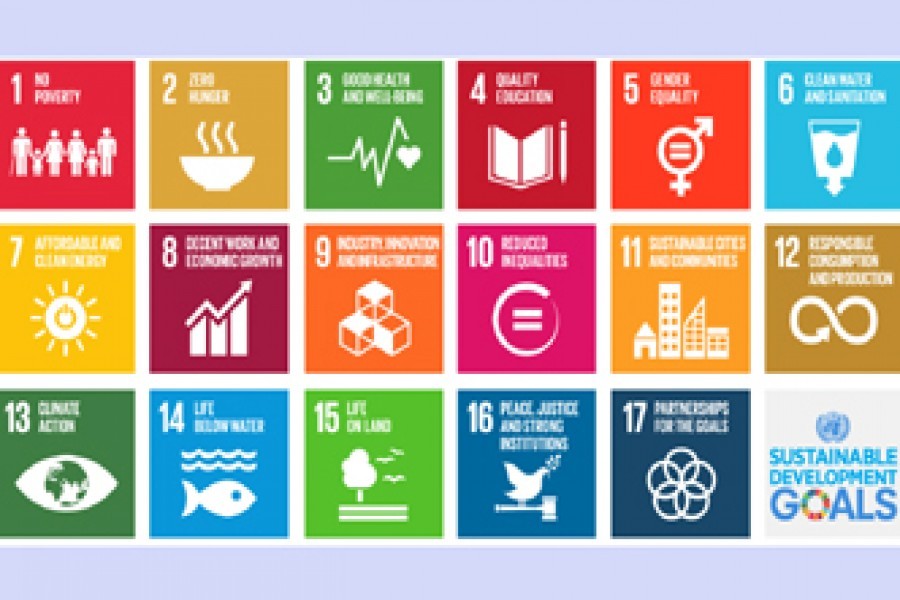The General Economics Division of the Ministry of Planning (GED) prepared a document titled, 'SDG Bangladesh Progress Report 2018'. The exercise was due because "our governments have the primary responsibility for follow-up and review, at the national, regional and global levels, in relation to the progress made in implementing the goals and targets over the coming fifteen years."However, that report was recently released in the presence of the Planning Minister MA Mannan, Economic Advisor to the PM Masiur Rahman, Eminent economist Wahiduddin Mahmud, Principal Secretary to the PM Nojibur Rahman, UNDP representative and the media. The presence of the galaxy, in fact, in itself instils the importance of the report first ever made for the first leg of a long journey. The evaluation was made on the basis of SDG M & E framework designed for 108 indicators.
The discussions by speakers mostly highlighted the paucity of relevant data because if the analysis is not based on credible data, target-wise inter-temporal comparison becomes not only very difficult but also produces deadly output. The exercise carried out by the GED possibly points to the crucial need for a credible national statistical organisation either by overhauling the existing BBS or setting-up a new one. It also gives a clarion call for making every ministry/division equipped with a strong statistics wing.
The progress shown in Sustainable Development Goals: Bangladesh Progress Report 2018 could be categorised into three distinct levels such as best, better and bad in the light of the achievements of SDGs. The best are those for which targets have already been achieved before the stipulated time; better indicates targets on track and the bad ones include the off-track targets needing due attention immediately.
The proportion of total government spending on essential services especially health and social protection seems to be on the rise and truly on track but education needs more attention, Even then the critics could argue that the total expenditure on essential services as proportion of GDP might have gone down in the face of GDP getting bigger in size. Secondly, the quality of spending also needs a closer look. The proportion of population below international poverty line as well as that of national lower poverty line (extreme poverty) is reported to be on track but that of below national poverty line - upper poverty line - seems to be off the track and hence need attention.
A few notable features are highlighted in the report such as the decline not only in the rate of poverty but also in the absolute number of the poor; rural poverty falling faster than urban poverty and incidence of poverty is lower among female-headed households than male ones; both stunting and wasting rates are reportedly on the track although prevalence of malnourishment among 15-49 years lack adequate data to comment on. Agricultural orientation and the total flows to agriculture need attention as most of the poor live in rural areas and live on this sector. The most perturbing trend, however, appears to be the falling rate of reduction in poverty over time and adducible mostly to the rise in income inequality in society. The report is hopeful of reaching the milestone in the wake of accelerating economic growth rate averaging more than 7.0 per cent in the coming years.
As far as the progress on "Healthy lives and Well-being" of people are concerned, the results seem to be satisfactory as the proportion of birth attended by skilled health personal being on track, and so is the total net ODA to medical research. The targets set for reduction of under-five and neo-natal mortality rates per 1000 live births have already been reached. Progress on maternal mortality rate per 100,000 live births seems painfully slow and need urgent attention. Progress on "Inclusive and Quality Education" bears a mixed bag. Gender disparities in primary level could be reached much earlier, that of secondary level is on track but gender parity at tertiary and technical levels need serious attention. Similarly attention needs to be paid to participation in organised learning. The performance relating to training, skill for youth is disheartening as it is for the rising inequality. Access to electricity now covers nearly 96 per cent of the population as well as the proportion of population with safely managed sanitation at 76 per cent is on track. Barring the average annual growth rate of real and real GDP per employed person that are on track, the dismal destination of others need attention - such as proportion of informal employment in non-agricultural employment by sex, unemployment rate by sex and disabilities, proportion of youth, aged 15-24, neither in education nor in work, average monthly earnings of male and female, because of importance in national uplift.
The report shows that most of the indicators for which data are available depict remarkable success. Especial mention may be made of access to internet facilities and mobile phones. However, the moot concern is financing SDGs both from internal and external sources. Tax-GDP ratio hovering around 10-11 per cent for a pretty long time is one of the lowest among comparable countries, Flow of FDI at feeble rate, fall in remittance flow and lack of utilisation of funds in the pipeline are some of the challenges for upcoming days as the report concludes by arguing that achieving SDGs will critically depend on the availability of resources and the enhanced cooperation and support from international communities.
A few important observations from Professor Wahiduddin Mahmud need mention: with such a low social/GDP ratio, Bangladesh's progress is praiseworthy, even unparalleled to be called a paradox; people of this country are eager to accept and adopt innovation and finally, the days of low-cost solutions to low-hanging are over and those of high-cost for high-hanging fruits are looming large on the horizon. It means more spending by raising resources, curtailing corruption and ensuring good governance.
Abdul Bayes is a former Professor of Economics at Jahangirnagar University.


